Novices, intermediates, and professional bodybuilders worldwide love the Dumbbell Fly.
The isolation movement helps you develop a complete, symmetrical, and chiseled chest. It’s an effective exercise for improving upper body strength, addressing weaknesses, and building chest muscles.
So, what are you waiting for? Why haven’t you added the Dumbbell Chest Fly to your workout routine? We cover everything you need to know to get started in the article below.
Jump to:
What Is the Dumbbell Chest Fly?
Dumbbell Flyes are an isolation exercise primarily engaging the chest muscles. Secondary muscles like the shoulders and arms are also activated.
The most common method is to lay on your back on a flat bench, but using an incline bench allows you to engage the upper chest muscles. Other variations include the cable machine, chest fly machine, and resistance bands.
Chest flys work to open the chest, stretching and challenging the muscle fibers. This can reduce tightness in the area and help you gain muscle mass. The shoulder recruitment is also beneficial for mobility, range of motion, and posture.
What Muscles Do Dumbbell Chest Flyes Target?
Understanding muscle activation, anatomy, and function will help you get the most out of your chest workout. When you know how the muscles work, you can identify weak points in your technique and start to master the correct form.
As a chest exercise, the dumbbell fly targets the two pectoral muscles:
- Pectoralis Major
- Pectoralis Minor
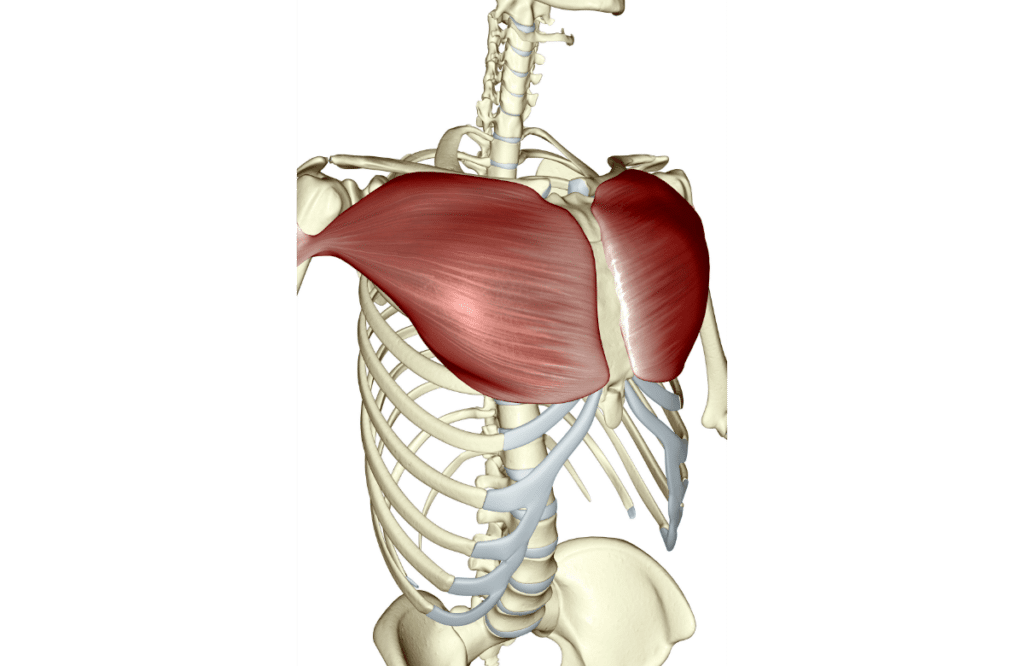
The movement also uses the shoulder, tricep, and biceps as stabilizer muscles. The chest fly exercise works as a chest opener, providing a mild stretch to reduce tightness in the area. The scapular retraction can strengthen the shoulder muscles and improve posture.
Pectoralis Major
The pectoralis major sits on top of the pectoralis minor. It’s the most significant, most visible muscle in the chest. It has a thick fan shape that connects to the rib cage. The pec major contributes the most to chest development, size, and strength.
- It allows you to bring your arms across your body, such as when performing exercises like the chest fly or hugging motion.
- Assists lifting the arms forward and upward, as in movements like reaching or throwing a ball overhead.
- The pec major helps rotate the upper arm inward, like when you’re reaching behind your back or throwing a punch.
The pectoralis major has two muscle heads—the upper and lower head. You can determine which area you emphasize by adjusting the movement or bench angle of the exercise.
Pectoralis Minor
The pectoralis minor has a thinner, smaller, triangular shape and sits right underneath the pectoralis major. It begins along the third to fifth rib, passing upward and over to connect to the
medial border and superior surface of the coracoid process.
The pec minor’s primary function is the stabilization, depression, abduction or protraction, internal rotation, and downward rotation of the scapula.
- During deep breathing or when you take a large breath, the pectoralis minor contracts to lift the ribs and expand the chest cavity, aiding in inhalation.
- The pectoralis minor pulls the scapula forward and around the ribcage, contributing to movements like reaching forward or pushing objects away from the body.
- It helps rotate the scapula downward by pushing down on a lever or performing a downward pulling motion.
The muscle works with other muscles to stabilize the shoulder joint. It helps you maintain proper form and control during upper body and chest isolation exercises.
Shoulders
The anterior or front deltoid muscles are the primary assistive muscles in chest isolation exercises. The shoulders are the primary, secondary muscle in nearly all compound chest exercises.
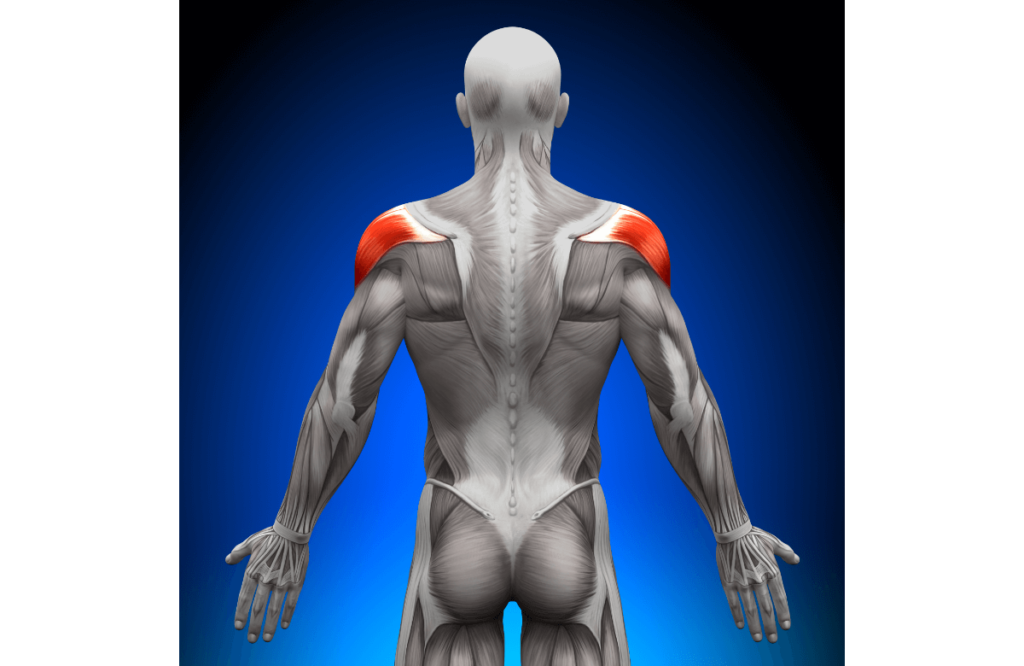
The incorrect technique can cause the shoulders to take the brunt of the load, which can lead to a higher chance of shoulder injury and strain. It’s critical to focus on the mind-to-muscle connection and feel the chest muscles contract.
Biceps and Triceps
The biceps and triceps are used as stabilizers during chest fly variations. They’re not overly involved, but your arms have to physically hold the load. The muscles have to contract as you maintain each rep, which can be beneficial for improving stability and range of motion.
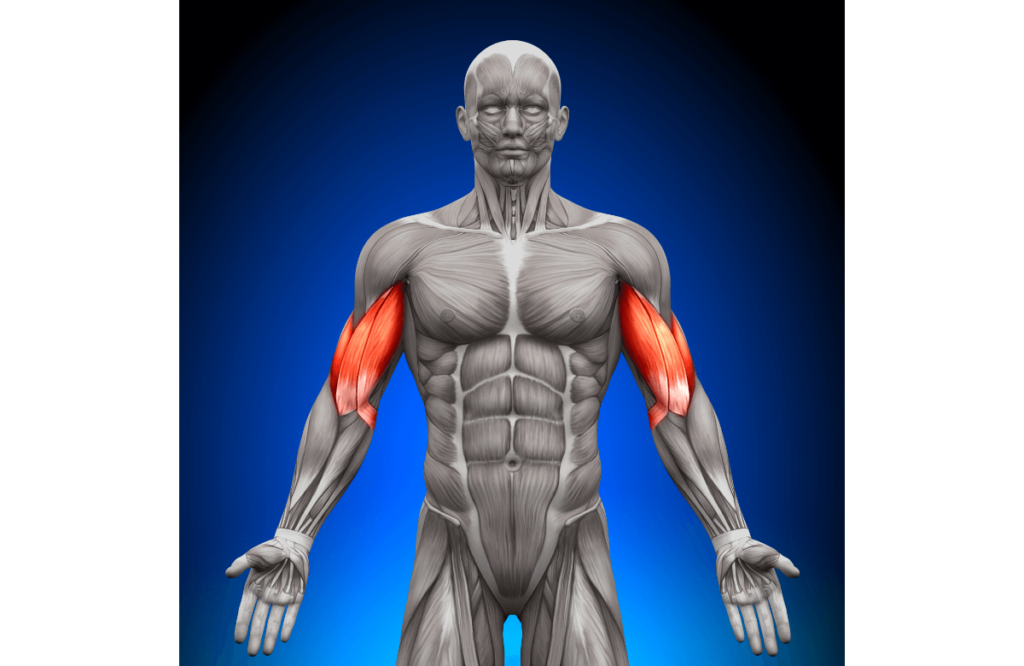
Dumbbell Chest Fly Benefits
There are several benefits from weight training, mainly when you include chest isolation movements like the fly into your training program. When it comes to chest growth and building muscle mass, most lifters opt for compound movements.
Chest presses are a go-to exercise, providing you with more chest strength, but they don’t offer complete chest development.
Exercises like the dumbbell fly can provide you with balanced chest development, variety, additional volume, and increased stability.
Chest Isolation
Bench presses, dips, and other multi-joint exercises surely help you build chest muscle mass, but it’s common for different muscle groups to take over. Overcompensation from other muscles can lead to muscle imbalances, weak points in technique, and even injuries.
The chest dumbbell fly allows for serious chest activation.
It’s an isolation exercise that allows you to address muscle imbalances and poor form and build more chest definition. If you have a lagging chest or need extra volume, it’s a must-have in your chest workout routine.
Build Bigger Pecs
Incorporating the dumbbell fly alongside other compound lifts, like the bench press, can help you develop a complete chest training program.
You can enhance muscle engagement from your main lifts without recruiting different muscle groups. It will help you strengthen any lagging areas of your chest, which can be helpful if it’s a weak point in your physique.
Enhanced Stability and Control
Dumbbells challenge the stabilizing musculature of the shoulder. Each arm holds one dumbbell requiring more stability, control, and muscle engagement. This helps to improve strength, control, and balance during upper body movements.
Versatility and Convenience
Let’s face it; we don’t all have the time, money, or luxury to get to the gym every week.
You might not live near a gym, or your local spot might lack equipment like cable machines.
That’s where dumbbell exercises come into play.
You can perform this movement with a set of adjustable dumbbells from the comfort of your living room. The training can also be modified to suit your fitness level by adjusting the weight and technique.
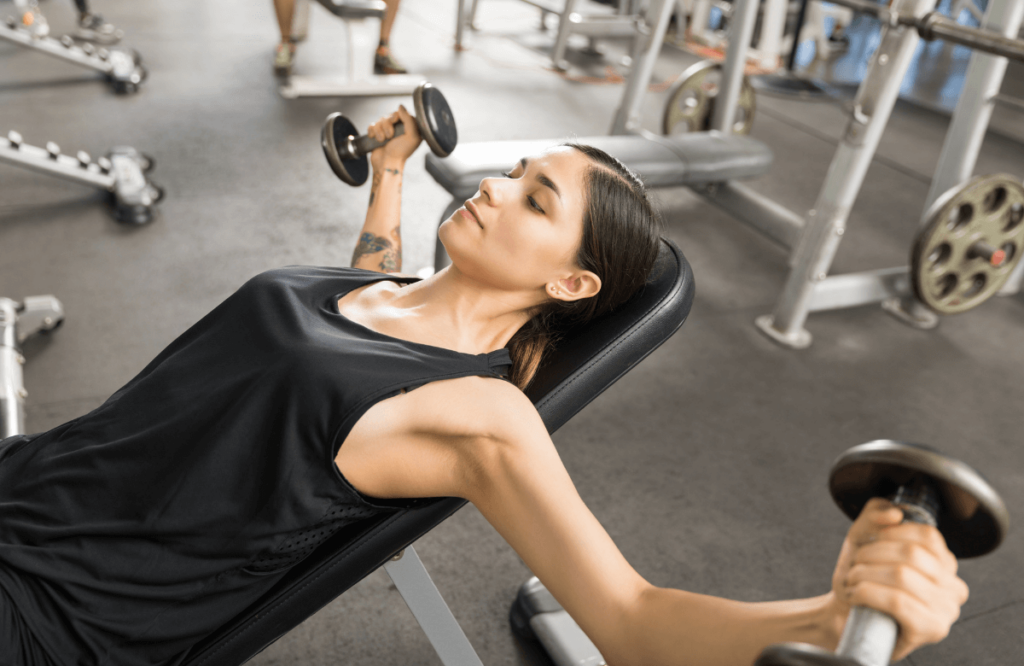
How to Perform
Isolation movements can seem straightforward, but the wrong technique can lead to overuse strain, poor muscle recruitment, and injury. That’s why it’s critical to perform the Dumbbell Chest Fly correctly.
Step 1: Setting Up
To begin, lie down on a bench with the dumbbells held straight above your shoulders, feet flat on the ground and knees slightly bent.
Grip a dumbbell in each palm, with your palms directed at each other. Extend your arms straight above the chest, with a slight bend in your elbows. This is your starting position.
Throughout the exercise, remember to keep your shoulder blades squeezed together and in contact with the bench.
Step 2: The Movement
Inhale and slowly lower your arms out to the sides in a wide arc, maintaining a slight bend in your elbows. Keep your palms directed at each other throughout the movement.
Continue lowering your arms until you feel a stretch in your chest muscles. Be cautious not to drop the dumbbells too far down, as it can strain your shoulder joints.

Step 3: The Finish
Now, exhale and begin to bring your arms back to the starting position by squeezing your chest muscles. Maintain control throughout the movement and concentrate on activating the chest muscles.
Pause briefly at the top of the exercise, squeezing the chest muscles before repeating the exercise. Imagine “hugging” the air with your arms, as this helps you activate the chest muscles during the training.
Rep Range and Training Frequency
Isolation exercises aren’t enough on their own to develop strength and muscle mass. That said, incorporating them into your chest sessions can provide you with more volume and muscle gains.
It’s recommended to use moderate weights so that you can perform three sets of 10–12 reps without losing control.
You should be near failure at the end of the sets but shouldn’t experience serious pain or incorrect technique.
Common Mistakes to Avoid
Like any other exercise, it’s common to make mistakes when you first learn a movement. Mistakes are par for the course but can be devastating if they aren’t addressed early on. The wrong technique can lead to injury, poor muscle recruitment, and bad habits.
Using Heavy Weights
Heavy weights can be the downfall of advanced and beginner lifters alike. It’s best to leave your ego at the door when stepping into the gym. Using heavier weights than you can handle can lead to bad form, poor muscle recruitment, and injury.
Instead, use lighter weights and work your way up over time. This allows you to learn the technique and avoid injury while challenging the muscles.
Incorrect Range of Motion
During a correct dumbbell flye, you start with your arms sticking out to the sides, forming a “T” shape. Then, you bring your arms closer together until they are parallel to each other.
The extent to which you can do this depends on your shoulder flexibility, but ideally, you should be able to bring the weights all the way down. By doing so, you engage more of your chest muscles, specifically the pecs.
Bending the Arms Too Much
Locking out the elbows can strain the joints and limit the amount of weight you can lift. On the flip side, bending the elbows too much recruits the biceps more, making the exercise less effective.
Instead, the elbow should be unlocked with a slight bend. This ensures the load is distributed evenly through the arm and chest.
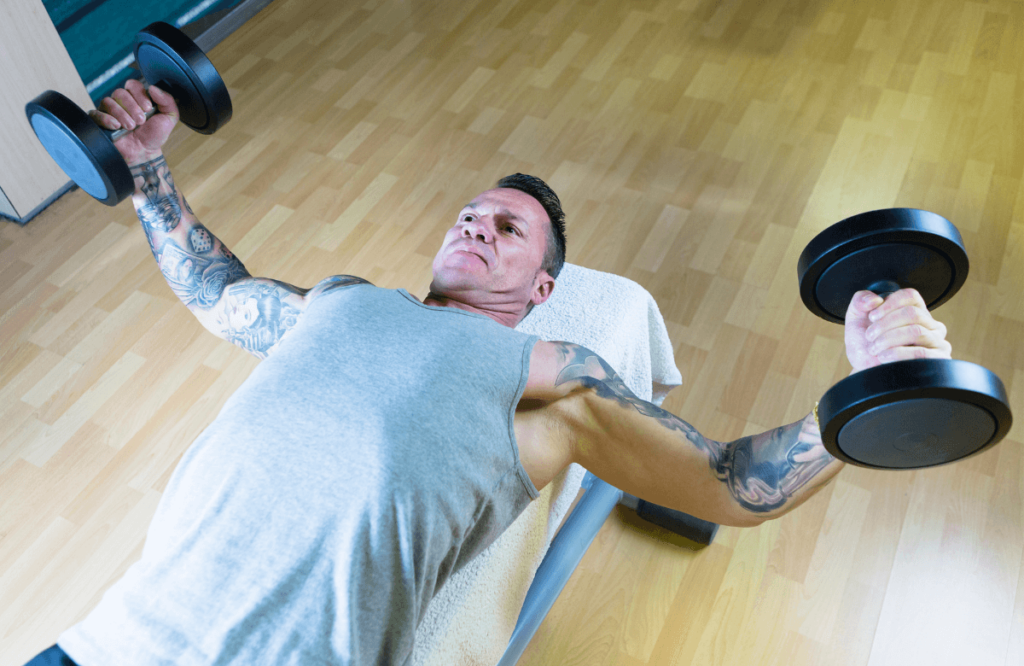
Dumbbell Fly Variations
As an isolation exercise, the dumbbell fly has several variations and modifications. Movements like the Incline Dumbbell Fly can emphasize different areas of the chest while cables can provide more time under tension and less stress on the joints.
Either way, you can adjust the exercise to suit your fitness goals, equipment, body composition, and preferences.
1. Incline Dumbbell Flyes
The Incline Dumbbell Fly is one of the most popular variations. The exercise requires an incline or adjustable bench set to 30–45 degrees. The slight angle helps you emphasize the upper chest, which can be a lagging point for advanced lifters and beginners.
- To begin, lie on an inclined bench that is angled at about 30 degrees. Keep your back flat against the bench. Grip a dumbbell in each hand.
- Begin with the arms positioned at chest level, bent at the elbows, and pointing outward.
- Take a slow breath out as you raise your arms above your chest.
- Breathe in as you gradually lower your arms back to the starting position by your sides.
- Repeat the pressing motion.
- Complete 10 to 15 repetitions of this exercise for three sets.
2. Decline Dumbbell Fly
Like its incline cousin, the Decline Dumbbell Fly uses a downward angle to emphasize a different chest portion. This movement targets the lower chest, which doesn’t get much attention compared to the middle and upper areas.
- Adjust the bench to a 30-degree decline position. Lie down, ensuring the bench supports your head and back, and plant your feet on the ground.
- Raise the dumbbells until they are aligned with your chest, with your palms directed towards each other. Keep a slight bend in your elbows.
- Draw your shoulder blades together, then take a deep breath as you slowly lower the dumbbells in an arc-shaped motion. Stop when your arms are nearly parallel to the ground and the dumbbells are aligned with your chest.
- Exhale as you contract your chest muscles and bring the dumbbells back together by squeezing them.
3. Machine Chest Flyes
The Chest Fly Machine can be a great alternative if you don’t have access to dumbbells or prefer a fixed range of motion.
The machine can also be useful if you have a lower-body injury that prevents you from standing. You must adjust the equipment so the seat and handles are comfortable.
- Sit in an upright position, making sure your neck and shoulders are relaxed. Keep your feet flat on the floor.
- Hold the handles of the machine with your palms directed forward. Release the handles by pushing a foot bar on some machines if necessary.
- Press your arms together in front of your chest maintaining a slow and controlled movement. Keep a slight bend in your elbows, and let your wrists stay relaxed.
- Pause for one second when your arms are fully closed in front of your chest.
- Slowly bring your arms back to the starting position, opening your chest and maintaining a strong and upright posture.
- Perform three sets of 8–12 repetitions. Take a short break between sets.
4. Cable Chest Flyes
The Cable Chest Fly is another machine variation. It’s safe, effective, and provides consistent tension throughout the exercise.
This challenges the muscles, allowing you to use lighter weights while seeing similar results. A staggered or traditional stance works; it just depends on your preferences.
- Begin by setting the pulleys on the cable machine to shoulder height, ensuring they are at the same level.
- Stand in the middle of the cable pulley machine with your feet positioned shoulder-width apart.
- Hold one handle of the cables in each hand, facing your palms forward. Extend your arms to the sides, maintaining a slight bend in your elbows.
- Take a step forward to create tension on the cables. This is your starting position.
- Exhale slowly and bring your arms forward in front of your body as if you are giving a big hug to a large tree trunk. Keep a slight bend in your elbows throughout the movement. Avoid letting your hands touch each other at the end of the motion.
- Pause briefly, then inhale as you gradually reverse the motion and bring your arms back to the starting position in a controlled manner.
- Repeat the exercise for your desired number of repetitions.
5. Standing Resistance Band Chest Fly
You’re not out of luck if you’re short on equipment but have resistance bands. The Standing Resistance Band Chest Fly can challenge the muscles, providing consistent tension like the cable machine.
You must attach the band around a sturdy support at roughly chest height. It’s best to focus on one arm at a side.
The only drawback to this movement is that it can be difficult to set precise resistance levels compared to the cable machine or free-weight variations.
Frequently Asked Questions (FAQ)
What Are Dumbbell Flys Good For?
Dumbbell Flys are excellent for isolating the chest, increasing shoulder stability, and adding more volume to your chest day. Each arm grips a dumbbell, so neither side can compensate for the other, helping you fix any weakness or muscle imbalances. It’s worthwhile to program dumbbell flys alongside other compound chest pressing exercises.
What Muscles Do Dumbbell Fly Work?
The Dumbbell Fly mainly engages the chest, while the shoulders, triceps, and biceps are stabilizers. It’s an isolation movement that can help you develop a fuller, more balanced chest. Opting for the incline or decline variations can help you target the upper and lower chest. These modifications are useful for addressing any weak or lagging areas.
What Are the Cons of Dumbbell Fly?
The Dumbbell Fly is an effective chest movement, but it can be hard on the shoulder joints and may not engage the muscles as much as other variations. It’s possible to overextend the arms, causing pain in the shoulder joint, especially if you’re using too heavy of weights. The cable machine variation may address these problems while providing consistent tension and recruiting more muscle fibers.













